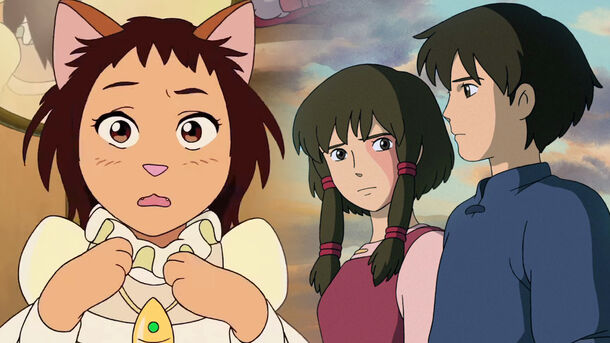10 Best Studio Ghibli Animations Made NOT By Hayao Miyazaki

Hayao Miyazaki is without a doubt one of the highlights of Japanese animation, but he is not the only one.
We love Hayao Miyazaki, but there are many other good directors in Studio Ghibli who speak about important things in the language of animation. War, death, pressure from society, the search for one's own way – all this is told through the stories of children and adults facing the big world.
1. Only Yesterday, 1991
In this unexpectedly mature and serious drama, Isao Takahata, co-founder of Ghibli and Miyazaki's constant collaborator, talks about everyday topics: first love, growing up, and nostalgia for a carefree childhood.
Only Yesterday is two parallel lines: the past and the present of twenty-seven-year-old Taeko. She has lived in Tokyo since childhood, and while her classmates went to the countryside for the summer, she spent her vacations in the city.
That's why, as an adult, Taeko loves to spend her vacations with relatives in the countryside, helping them pick saffron. As Taeko prepares for another trip, her sister tells her that at her age, it's time to stop being so frivolous and think about marriage.
2. The Cat Returns, 2002
This short adventure film was made with the aim of involving the younger generation of animators in the work of the studio. Responsibility for the feature-length version was given to newcomer Hiroyuki Morita.
High school student Haru risks her life to save a cat from being hit by a car. Suddenly, the cat thanks her in a human voice and promises to reward her. That same night, a procession of cats led by the Cat King arrives at Haru's house, and the girl learns that the cat she saved is the Prince of the Cats' Kingdom.
In gratitude, the cats shower Haru with their gifts and then declare that she must come to their kingdom and marry the prince.
3. The Secret World of Arrietty, 2010
This is an adaptation of Mary Norton's novel about Borrowers – little people who live in ordinary houses and steal sugar, pins, clothespins, napkins and other necessities. It was made by the youngest director in the history of Ghibli, a student of Hayao Miyazaki, Hiromasa Yonebayashi.
Arrietty is a Borrower, very brave and curious. She is not afraid to go outside, even though danger awaits her at every step: from the threat of being eaten by a frog to being caught by a human.
One day, a boy arrives in the house where the Arrietty family lives – twelve-year-old Sho, who suffers from a heart defect. His mother used to live in this house, and she believed in little people and told him about them.
4. My Neighbors the Yamadas, 1999
An ordinary Japanese family, the Yamadas, lives in a Japanese city. A father tired from work, a mother completely immersed in housework, a son with a pile of teenage problems, a cheerful daughter, a grumpy mother-in-law who is full of energy at her 70, and a beloved dog who silently watches the cycle of life unfold around it.
Far from being a traditional anime, Isao Takahata's film is a veritable encyclopedia of everyday Japanese life.
5. Whisper of the Heart, 1995
Yoshifumi Kondo’s animation tells about a high school student Shizuku, who likes to spend all her free time reading. One day she notices that all the books she borrows from the school library have the same teenager's name on them. After meeting him, Shizuku falls into the vortex of first love.
As is often the case in Studio Ghibli films, reality and fantasy are so intertwined here that it is not clear where one ends and the other begins.
6. When Marnie Was There, 2014
When Marnie Was There by Hiromasa Yonebayashi is the studio's first feature film made without the direct involvement of masters Miyazaki and Takahata.
Twelve-year-old Anna, an introverted and uncommunicative girl, moves in with her adoptive mother's relatives for the summer due to health problems. There she meets a girl named Marnie, who becomes her best friend. But it is not the only thing that binds Anna and Marnie.
7. From Up on Poppy Hill, 2011
A story about two orphans in post-war Japan, ten years after the end of the Korean War. Schoolchildren Umi and Shun find each other by chance and learn the circumstances of their birth. All this takes place in Yokohama, a port city near Tokyo, in a school where the students study chemistry, philosophy, or publish a daily newspaper.
A romantic story with unforgettable landscapes and everyday sketches of the Japanese 1960s was written by Hayao Miyazaki and directed by his son Goro Miyazaki.
8. The Tale of the Princess Kaguya, 2013
This is one of the most prominent and criminally neglected highlights of Studio Ghibli, which became the last in the career of Isao Takahata.
For his last film, the master chose the oldest known Japanese legend – The Tale of the Bamboo Cutter. The simple story of a moon princess thrown to earth by fate takes on an astonishingly philosophical tone in Takahata's hands, resulting in an incredibly heartbreaking finale.
9. Tales from Earthsea, 2006
In Earthsea, crops are dying from drought, people are falling ill, and wizards are forgetting their spells. Suddenly, 17-year-old Prince Arren kills his father, the king, and flees the palace with a magic sword. Wandering through the desert, the young man encounters a lonely wanderer who turns out to be the supreme wizard the Sparrowhawk.
This is an interpretation of Ursula K. Le Guin's Earthsea series of novels, directed by Goro Miyazaki. It is his first directorial work, which of course could not avoid comparisons with the works of his father. But if you watch Tales without considering that it was made by the son of one of the most prominent animators in Japan, then you can undoubtedly enjoy it.
10. Pom Poko, 1994
This is yet another work of Isao Takahata, in which reality collides with ancient Japanese myths. Set in modern Japan, the story tells about the magical creatures, tanuki (raccoon dogs), who fight against the development of high-rise buildings on the outskirts of Tokyo. To confront the stubborn humans, they revive the ancient method of transformation and launch a military operation to save their habitat.
In this way, Studio Ghibli tried to draw attention to the real extinction of these rare wild animals in the built-up areas of the country.
